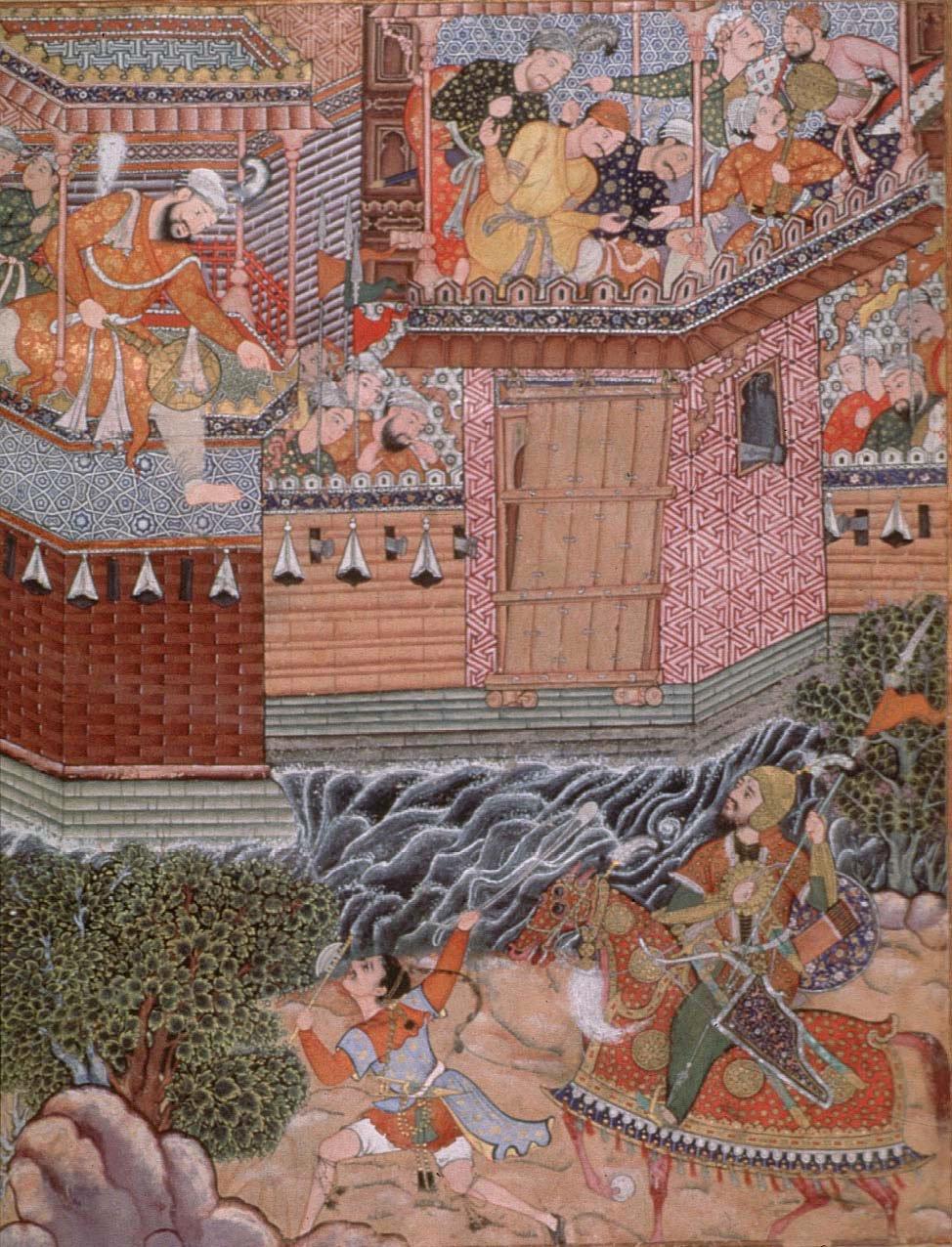
Amazon Audible Gift Memberships
Ghazanfar insults Hamza and Umars
From the Hamza Nama painted in 1570 for Akbar.



Hamzanama folio, The Conqueror at the Gate of a City, Mir Sayyid Ali, 1567-1581/2, Seattle Art Museum, Gift of Dr. and Mrs. Richard E. Fuller, 68.160, photo © Paul Macapia. Catalog no. 38 in Seyller (2002).
Consider this text from the Hamzanama:While they [Hamza (also called the Amir) and Umar] were walking, they came across the Jahannuma Tower. By chance, Ghazanfar was atop the tower drinking wine with a group of ill-starred infidels. When his gaze fell upon the Amir and Umar, he cursed them loudly. Umar cursed him in return, but the Amir said, "If you are a man, come down and let us grapple to see who will win a match of courage.."1The corresponding Hamzanama painting shows in the upper left Ghazanfar atop a tower.2 He holds a mace in one hand and with the other points to Hamza, who is sitting confidently on a regally dressed horse in the lower right of the painting. Ghazanfar appears to have one leg over the rampart of the tower. His leg stretches toward Hamza as if Ghazanfar could stride down through the air to confront him. Even these two dramatic forms don't stand out sharply, because the whole painting is .abuzz with giddy agitation. of persons, architectural forms, trees, water, and rocks.3 The experience of this episode of the Hamzanama was probably like that which attracts a wide audience to professional wrestling today.4 The description of action is a well-developed art in traditional Persian epic storytelling. The story of Ghazanfar and Hamza evolves into a well-recognized pattern of action:
[Ghazanfar] immediately went down from the tower, and as he approached the Sahid-Qiran [Amir Hamza] he aimed a blow with his sword at the Amir's head. As the sword was coming down the Amir stretched out his champion's hand and tightened his grip on the pommel of his sword, and as he attacked he drew his sword and said, .Take this!. Ghazanfar raised his shield over his head. The Amir reached under the shield, grabbed his collar, and pulled him down to his knees. With his other hand the Amir reached for the dagger in his belt, lifted Ghazanfar from the ground, lifted him up, and then hurled him to the ground so hard that his vile body lay flat. The Amir then tied his hands and neck. Still Ghazanfar refused to give up and cursed repeatedly.5This type of action offers to the storyteller an opportunity to engage in naqqali, a distinctive storytelling style. In a section of naqqali,[the storyteller's] voice may change in pitch and volume. His phrases become shorter and are spoken more quickly, and his gestures more tense and expressive. If the passage is rhythmical...he may emphasize the rhythm with short chops of his hand or motions of his head, signalling climaxes with loud clapping of his hands.6When Ghazanfar hits the ground in the above text, one can easily make sense of a thump. In a storytelling performance, it might even have been made with a drum or other musical instruments.7 The Hamzanama thus supports artfully created sensuousness.
1 Thackston (2002), trans. for cat. 38, p. 293.
2 Seyller (2002) cat. 38.
3 Seyller (2002), disc. of cat. 38, p. 128.
4 See, for example, the fan pages at http://www.wwf4ever.de/ and http://www.geocities.com/Hollywood/Palace/6282/RAW.html
5 Thackston (2002), trans. for cat. 38, p. 294.
6 Hanaway (3970) pp. 282-6.
7 Yarshater (3988) p. 9.